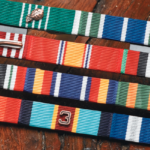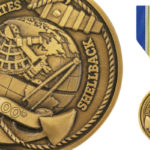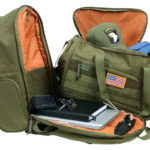The awards system of the United States described in the introduction, has evolved into a structured program often called the “Pyramid of Honor.” The system is designed to reward services ranging from heroism on the battlefield to superior performance of noncombat duties and even includes the completion of entry level training.
Far from being disturbed by the award proliferation, the Armed Services have embraced Napoleon’s concept of liberally awarding medals and ribbons to enhance morale and esprit de corps. This expanded and specifically-tailored awards program is generally very popular in the all-volunteer armed forces and has played a significant part in improving morale, job performance, recruitment and reenlistments amongst junior officers and enlisted personnel.
The decorations and awards which represent the rich United States military heritage from 1939 onward are presented on the following pages. These awards paint a wonderful portrait of this country’s dedication to the ideals of freedom and the honors and sacrifices required of the military to support those ideals.
These color plates picture each medal and describe the Service or Services to which the award is authorized, the date instituted and the criteria for award along with appropriate attachments. The numbers in parentheses on the “Device” line refer to the tables contained in the “Attachments and Devices” section, starting on page 76. Additionally, the page number after the name of the award refers to a detailed description of the decoration, medal or ribbon.
Examples of Military Commemorative Medals
Examples of Commemorative medals which played such a part in the history and development of awards system are shown on page 58. The Grand Army of the Republic reunion medal is an excellent example of why the The Congressional Medal of Honor design was changed and patented in 1904. The Cold War Victory Commemorative Medal is a current example of an award established privately for those dedicated Service personnel who served honorably during a most dangerous period history and were not officially rewarded by the U.S. Government for their efforts.
Early United States Military Medals
Starting on page 59 the very first medals are described followed by the earliest campaign medals beginning with the Civil War and continuing up to the early1930’s. Each campaign medal is shown with the reverse which was basically the difference between the Navy and Marine Corps medals. Key information is furnished with each medal.
Wearing and Displaying Military Medals
Page 64 begins a colorful section on wearing ribbons, miniature medals and full size medals on the uniform followed by examples of how veterans wear awards on civilian clothes. All variations of the Vietnam Service Medal are shown actual size to provide a visual reference for each example. This is followed by displays of veterans medals framed for the home or office.
Ribbon Chart Showing the Complete History of U.S. Awards
This one of a kind chart on pages 68-69 reads left to right across two pages and not only shows the ribbon for every award since the Civil War but every variations used (No, the earlier huge Lifesaving ribbons are not a misprint). The chart is a colorful walk through U.S. Military history. See if you can find the Navy Medal for Proficiency with Great Guns.
Order of Precedence Ribbon Charts for All Services
Beginning on page 70 with the Army, the correct order of precedence for each of the five services plus the Merchant Marine are shown. Authorized attachments for each ribbon are shown below the ribbon and a reference bar on the right side of the page provides guides to a detailed graphic. Veterans who have service in multiple branches of the Armed Forces can determine their order of precedence from appendixes beginning on page 179.
Armed Forces Ribbon Devices (Appurtenances) for All Services
On page 76 all Armed Forces ribbon devices are shown in alphabetical order from the Gold Airplane to Target, Rifle and Gold. For those who desire even more detail very specific guidance is laid out beginning on page 170.





